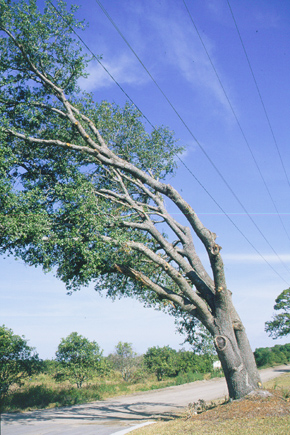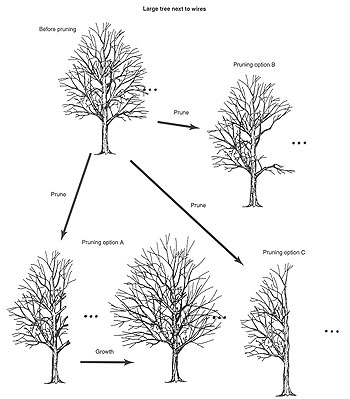Home > Pruning shade trees > Pruning near utility lines
Pruning near utility lines 
Electric utility contractors prune trees to ensure safe, reliable service to their customers and to gain access to utility structures. The practice is referred to as line clearance. Homeowners, horticulturists, and other persons without Electrical Hazard Awareness training must leave this to a line clearance tree trimmer or trainee. Call the utility company or a utility arborist to do this hazardous work. Never prune within 10 feet of a utility conductor unless you have the appropriate training.
Ice, snow, and wind can break branches growing above and among wires and cause the wires to malfunction or break. This disrupts electric service to homeowners and businesses. Therefore trees are pruned to direct their growth away from the wires (see right photo). Controversy sometimes arises when property owners think that their trees were pruned inappropriately or too severely. Though sometimes mistakes are made, the contractor performing the work is typically following specifications as directed by the utility. Utilities should be following ANSI pruning standards and the Best Management Practices for utility pruning published by the International Society of Arboriculture.
Objectives
To improve reliability of electric service in urban and rural communities.
Execution
Directional pruning (also called lateral pruning) guides the tree to grow in a certain direction by removing live branches from other portions of the tree. Reduction and removal cuts are typically employed in directional pruning. This is especially useful near buildings, roads, walks, streetlights, and overhead utility wires. As with other tree pruning, directional pruning usually provides for only a temporary solution. Ample access to sunlight usually means that branches will return to the portion of the tree that was reduced. 
Examples of directional pruning.
Option A is a poor choice because sprouts from heading cuts quickly grow back into the wires, and the headed branches then decay. For a lower maintenance alternative, reduce the length of and then at a later date remove the branches. Some companies choose between options B and C because they provide clearance for a longer time. Option C provides the best clearance but is over pruning that can result in sun-scald, cracks and trunk decay.

